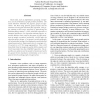Free Online Productivity Tools
i2Speak
i2Symbol
i2OCR
iTex2Img
iWeb2Print
iWeb2Shot
i2Type
iPdf2Split
iPdf2Merge
i2Bopomofo
i2Arabic
i2Style
i2Image
i2PDF
iLatex2Rtf
Sci2ools
117
Voted
ICCV
2003
IEEE
2003
IEEE
Graph Partition by Swendsen-Wang Cuts
Vision tasks, such as segmentation, grouping, recognition, can be formulated as graph partition problems. The recent literature witnessed two popular graph cut algorithms: the Ncut using spectral graph analysis and the minimum-cut using the maximum flow algorithm. This paper presents a third major approach by generalizing the Swendsen-Wang method? a well celebrated algorithm in statistical mechanics. Our algorithm simulates ergodic, reversible Markov chain jumps in the space of graph partitions to sample a posterior probability. At each step, the algorithm splits, merges, or re-groups a sizable subgraph, and achieves fast mixing at low temperature enabling a fast annealing procedure. Experiments show it converges in 230 seconds in a PC for image segmentation. This is 400 times faster than the single-site update Gibbs sampler, and 20-40 times faster than the DDMCMC algorithm. The algorithm can optimize over the number of models and works for general forms of posterior probabilities, so...
Computer Vision | Graph Cut Approaches | Graph Partition Problems | ICCV 2003 | Maximum Flow Algorithm | Popular Graph Cut | Spectral Graph Analysis |
Related Content
| Added | 15 Oct 2009 |
| Updated | 15 Oct 2009 |
| Type | Conference |
| Year | 2003 |
| Where | ICCV |
| Authors | Adrian Barbu, Song Chun Zhu |
Comments (0)

